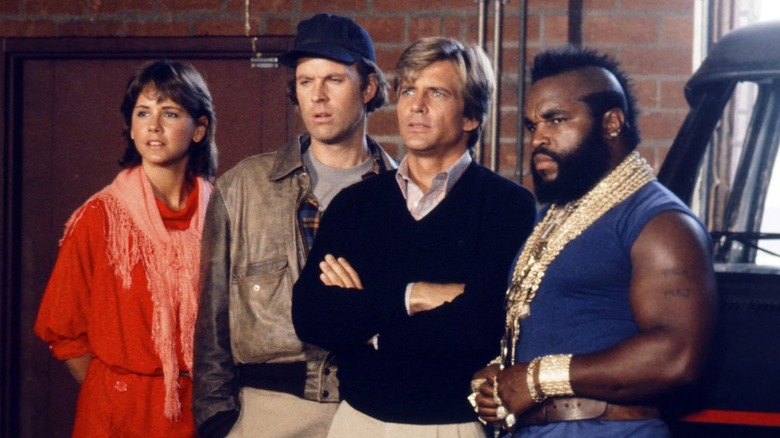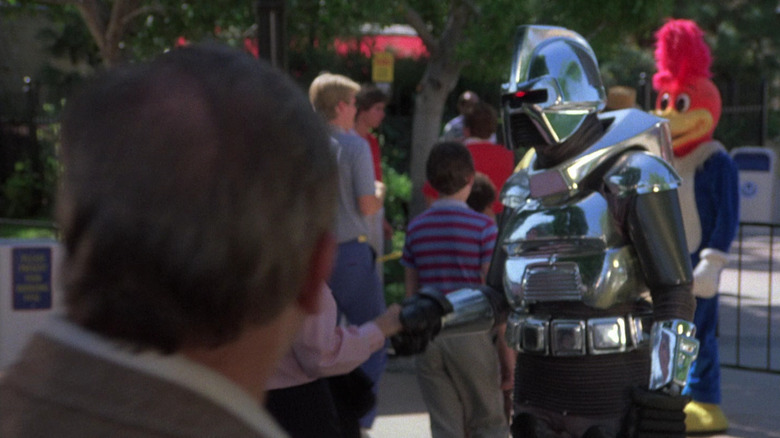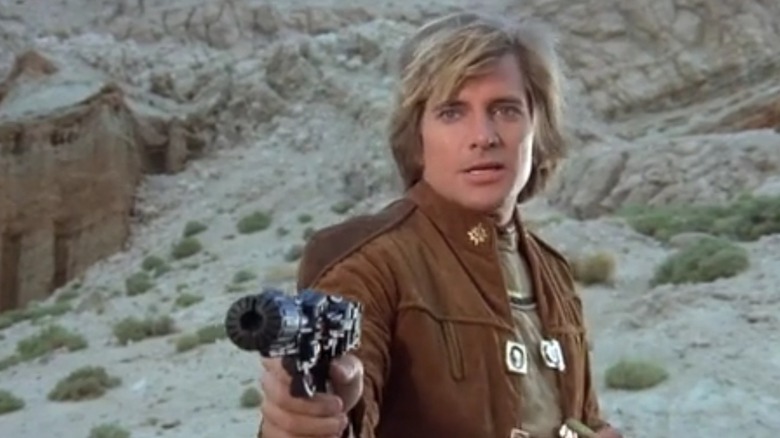How A Cylon From Battlestar Galactica Ended Up In The A-Team's Opening Credits
In 2023, crossovers and multiverses of madness are all the rage in the arts and media, the IP machine grafting other pieces onto itself in an ever-expanding effort to pull in mass audiences. Yet the initial creative impulse at the core of crossovers — "Hey, wouldn't it be cool if X met Y?" — goes much further back into history than the beginning of the Marvel Cinematic Universe.
Due to pesky issues like copyright law and the like, most crossovers in films prior to the MCU tended to be either "wink-wink" references or cameo appearances. Television was another matter, however; thanks to so many popular shows airing on a single network (and those shows usually sharing a production company, at least), many characters from sitcoms, dramas, and other series turned up for an episode or two on a sister show. This happened often enough that, beginning in the 1980s, the bizarre phenomenon known as the "Tommy Westphall Universe" inadvertently began (look it up).
Of course, sometimes these crossovers would take the form of winking jokes, and weren't always necessarily planned. Take, for instance, the appearance of a Cylon from the original "Battlestar Galactica" in the opening credits of "The A-Team." Even though both shows were created by Glen A. Larson and starred actor Dirk Benedict, this appearance wasn't part of a planned crossover, but rather an inside joke that ended up making the show itself.
Starbuck does an about face
As it turns out, the Cylon's appearance in the "A-Team" opening credits was all thanks to Benedict, who played Arthur Templeton "Faceman" Peck in the series. According to an interview Benedict gave in 2012, the actor initially intended the crossover to be a one-off inside joke. He explained:
"I take full responsibility, full credit for that. We were actually shooting at – we didn't, the A-Team was never filmed at a studio, but occasionally we're at Universal because it was a Universal show. We were always out on location, but this one episode we shot on the lot, and we were shooting there, and there was a Cylon just walking by from the tour that they do, and I saw him and I went to the director I said, 'Oh, oh, oh! Before we — at the beginning of this next scene, just have that Cylon walk in front of me.' 'Oh, well, why?' I said, 'No, just, I got an idea.' What I did, you know, just looked at him like, 'Don't I know you?' Just, then we went on with the scene, just as a joke for dailies."
Of course, the little "joke" Benedict staged ended up tickling the makers of "The A-Team" enough that they decided to put the moment in the opening credits, using the clip as part of Benedict's starring title card montage.
Just a joke ... or is it?
Given the disparate natures of "Battlestar Galactica" and "The A-Team," it's pretty clear that the brief moment where Faceman encounters a Cylon isn't intended to be read as any sort of crossover between the canon of both series, and is just a cute little reference to Benedict and Larson's other work.
That being said, Larson's "Battlestar" tended to make some pretty big sci-fi/magical realism leaps in logic during its short run, and even more during the (even shorter) run of sequel series "Galactica 1980." For one thing, "Battlestar" is eventually revealed to take place concurrent with real-time Earth history (as opposed to its 21st-century remake), with Starbuck and his friends just barely missing a transmission of the Apollo 11 astronauts landing on the moon at the end of the series' last episode, "The Hand of God." In the last episode of "Galactica 1980," entitled "The Return of Starbuck," it's revealed that Starbuck was last seen stranded on a remote planet.
Since "Galactica 1980" explicitly set the world of "Battlestar" in the then-present, and Starbuck was technically still alive as the series came to a close, would it not be possible that some sci-fi shenanigans occurred, where Starbuck was cloned, or his memory was wiped, and he then found himself on Earth where he was given the name of an orphan called Richard Bancroft?
Well, probably not. To paraphrase Sigmund Freud, sometimes a Cylon is just a Cylon.


